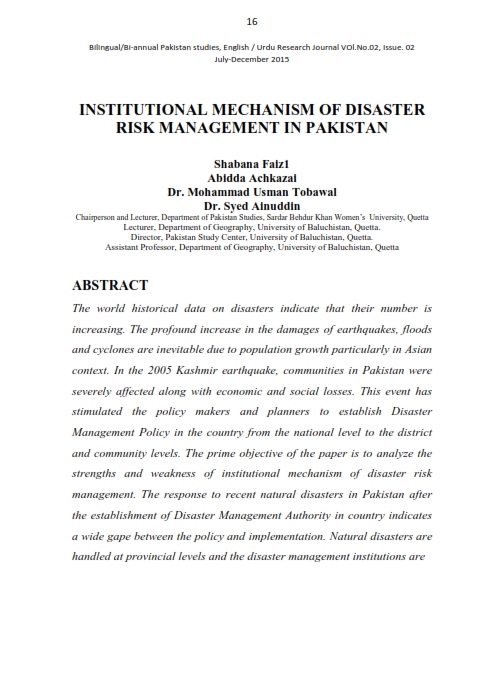INSTITUTIONAL MECHANISM OF DISASTER RISK MANAGEMENT IN PAKISTAN
Keywords:
Institutional Mechanism, Risk Management, Strengths, PakistanAbstract
The world historical data on disasters indicate that their number is
increasing. The profound increase in the damages of earthquakes, floods
and cyclones are inevitable due to population growth particularly in Asian
context. In the 2005 Kashmir earthquake, communities in Pakistan were
severely affected along with economic and social losses. This event has
stimulated the policy makers and planners to establish Disaster
Management Policy in the country from the national level to the district
and community levels. The prime objective of the paper is to analyze the
strengths and weakness of institutional mechanism of disaster risk
management. The response to recent natural disasters in Pakistan after
the establishment of Disaster Management Authority in country indicates
a wide gape between the policy and implementation. Natural disasters are
handled at provincial levels and the disaster management institutions are
not yet established at the local levels that exacerbated the people’s
vulnerability to a considerable level. Without established of these
institutions, risk reduction may not take place at local levels.
References
Ahmed, F. (2008). "Managing the Earthquake of 2005." Journal of South
Asia Disaster
Studies 1(1).
Bilham, R. (2009). "The seismic future of cities." Bull earthquake
Engineering7: 839-887.
Bilham, R., Hough, S. (2006). "Future Earthquakes on the Indian
Subcontinent: Inevitable
Hazard, Preventable Risk “South Asian Journal 12: 1-9.
Coburn, A., Spence, R. (1992). EARTHQUAKE PROTECTION, John
Wiley & Sons Ltd,
Canada.
Cochrane, H. (2008). "The role of the affected state in humanitarian
action: A case study on
Pakistan." Humanitarian policy Group overseas development
institute, London, United Kingdom
CRED (2011). EM-DAT online databases on Disasters (Centre for
Research on the
Epidemiology of Disasters).
Gaillard, J., Texier, P. (2010). "Religions, natural hazards, and disasters:
An introduction."
Religion40(special issue): 81-84.
Guha-Spair, D., Vos, F. (2010). "Earthquakes: epidemiological
perspective on patterns and
trends." A draft paper submitted to Human casualties in natural
disasters: progress in modeling and mitigation: 1-18.
Halvorson, S. J., Hamilton, J. P. (2007). "Vulnerability and the Erosion of
Seismic Culture in
Mountainous Central Asia." Mountain Research and Development
(4): 322-330.
Halvorson, S. J., Hamilton, J. P. (2010). "In the aftermath of the Qa'yamat:
the kashmor
earthquake in northern Pakistan." Disasters 34: 184-204.
ICG (2006). "Pakistan: Political Impact of the Earthquake, International
Crisis Group, Asia
Briefing N0. 46 Islamabad/Brussels, 15, March 2006".
Keridis, D. (2006). "Earthquakes, Diplomacy, and New Thinking in
foreign Policy." The
Fletcher Forum of World Affairs30(1): 207-214.
Leon, D., Villagran, J. C. (2006). "Vulnerability A Conceptual and
Methodological Review
institute of Environment and Human security." United Nations
University- EHS.
McGirk, J. (2005). Kashmir: the politics of an earthquake open democracy
free thinking for
the world, Retrieved on October 20th from the website
www.opemDemocracy.net
NDMA (2007). Earthquake-8/10 Learning from Pakistan's Experience,
National Disaster
Management Authority.
PMD (2007). "Seismic hazard analysis and Zonation for Pakistan, Azad
Jammu and
Kashmir." Pakistan Meteorological Office.
Uitto, J. I. (1998). "The geography of disaster vulnerability in megacities."
Applied
Geography 18(1): 7-16.



